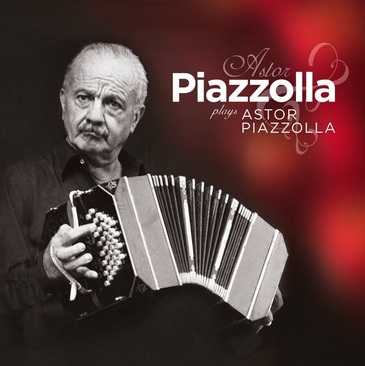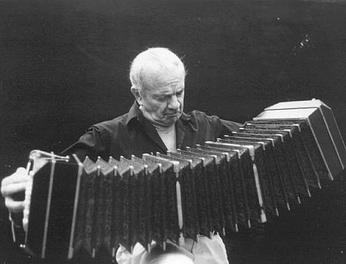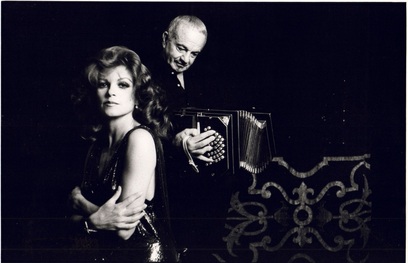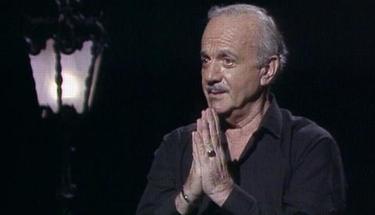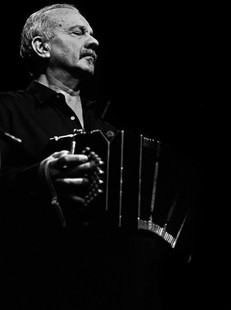Piazolla Astor (1921 - 1992)
|
Astor Piazolla was born March 21st, 1921 in Mar del PLata, Argentina. In 1925 the family moved to New York, where they stayed till 1936.
In 1929, when Astor was 8 years old, he got his first bandoneon from his father. During one year he studied with A. D. Aquila, with whom he made his first recording "Marionette Spagnol". In 1933 he studied with the Hongarian pianist Béla Wilda, who had been a student of Rachmaninov. About him Piazolla said "he made me appreciate Bach". A short time later he met the famous tango-singer C. Gardel, who became a close friend to the family. Through Gardel Piazolla got a role as newsboy in the movie "El dia que me quieras", in which Gardel had the leading role. In 1936 Piazolla moved back to Mar del Plata. There he became member of a few tango-orchestras and there he also heard for the first time the E. Verdaro Sextet on the radio. Piazolla got impressed by the original way Verdaro approached the tango and later he would ask him as violist in his own orchestra. |
In 1938 Piazolla moved to Buenos Aires, where he played in second class tango orchestras till 1939. But it was his dream to play in the orchestra "Anibal Troilo y su Orquestra Tipica". This was one of the best tango orchestras at that time and Troilo was one of the best bandoneon players. In order to reach a higher musical level Piazolla started new musical studies, with A. Ginastera as his teacher and later he took pianolessons from Raul Pivak. Troilo's orchestra played the works Piazolla wrote, but re-arranged them thoroughly in order to make it possible to dance on his music: the musical level of Astor Piazolla was too high.
|
In 1943 Piazolla started composing more classical music with"Suite para Cuerdas y Arpas" and in 1944 he left Troilo's Orchestra for being able to lead the Orchestra where Fiorentino was a member of. He played together with Fiorentino during two years and thereafter he formed his own orchestra, which only lasted for three years. But this orchestra had given him the possibility to follow his own creative ideas and his own dynamic and creative touch. The way he composed tangos was more modern and different, which caused the first controversies with the traditional tangueros.
In 1946 Piazolla composed "El Destande", after him his first official tango. Only a short time later he started composing filmmusic. This was the beginning of Astor Piazolla searching for something new and in 1949 he stopped with the orchestra and almost stopped completely with the tango. He continued studying the work and life of Béla Bartok and Igor Stravinsky, he studied conducting with H. Scherchen and he also got interested in jazz. He got obsessed with the idea of finding an own style and he longed for .something which had nothing to do with tango. Everything became a mess, Piazolla left the bandoneon and decided to devote himself to the study of music. |
During the years 1950-1954 Piazolla composed works which were totally different from the tango of that moment and which defined his unique style: Tanguango, Preparense, Contrabajeando, Triunfal are only a few examples. In 1953 he introduced his symphonical work "Buenos Aires" (three parts and composed in 1951) for the Fabien Sevitsky Contest, which he won. The piece was played by the Symphonical Orchestra Radio del Estado, with addition of two bandoneons. The concert resulted in a fight: the public did not accept that the bandoneon lost its dignity, while being used in a symphonical orchestra.
|
Winning this prise allowed Piazolla to start studying in Paris with N. Boulanger. He tried to hide his past as a composer of tango and works for bandoneon, as he thought his future was in classical music. But when he talked about this idea to Boulanger and as he played his tango "Triunfal" for her, she convinced him to go on writing tangos, as in this music she recognised the real Piazolla.
From that moment on Piazolla returned to the tango and his bandoneon and where in earlier days he had to choose between tango and the more complicated music, he started to combine them. In Paris he also started composing tangos for string orchestra. Himself, he no longer played the bandoneon sitting down, which is the usual way, but he played standing upright. As Piazolla returned to Argentina, he continued composing for string orchestras and he also started e new group, The Octeto Buenos Aires. He combined one cello, two violins, two bandoneons, two contrabasses and one piano. Now we do see that his |
work was inovative, he did not write for the traditional tango orchestra, but he wrote chamber music, music without a singer or dancer. As he followed his own way more than ever, and as he withdrew himself more and more from the traditional tango, the traditional tangueros got furious and Piazolla became target of low and mean criticism. But Piazolla was determined to go on following his feelings, the media and the studios were determined as well and this was the beginning of a cold war. In 1958 Piazolla left the Octeto, he left Argentina and went back to New York.
During the years 1958 - 1960, Piazolla composed in the United States of America, where he experimented with the jazz-tango. But this only gave him negative reactions. Yet it was during this period that he wrote "Adios Nonino", in memory of his deceased father. When he returned to Argentina in mourning he formed the first of his famous quintets, using a violin, a contrabas an electrical guitar, a piano and a contrabas. This quintet gave Piazolla the best posibility to express his feelings of the moment.
During the years 1958 - 1960, Piazolla composed in the United States of America, where he experimented with the jazz-tango. But this only gave him negative reactions. Yet it was during this period that he wrote "Adios Nonino", in memory of his deceased father. When he returned to Argentina in mourning he formed the first of his famous quintets, using a violin, a contrabas an electrical guitar, a piano and a contrabas. This quintet gave Piazolla the best posibility to express his feelings of the moment.
|
In 1963 Piazolla played "Tres Tangos Synfonicos", directed for the first time by P. Klecky. In 1965 he made two of his most important recordings: Piazolla at the Music Hall New York and El Tango.
In 1968 he started working with the poet Horacio Ferrer, with whom he composed "Operita Maria de Buenos Aires". With this he found a new style: the tango-song. At that time he also started working together with Amelita Baltar. The "Operita" had its premiere in the same year and before 1968 had ended, it had been performed about 120 times and it had also been recorded on an LP. In 1969, together with H. Ferrer again, Piazolla composed Balada para un Loco, which earned him a second place at the First Iberoamrican Music Festival. This work would be Piazolla's first hit. |
In 1970 Piazolla returned to Paris, where he composed El Pueblo Joven together with Ferrer. The same year he founded a new group, Conjunto 9, with which he performed mostly in Buenos Aires and Italy. This was the group Piazolla had always dreamt of, as with them he was able to perform all his complicated music. Yet, due to economical reasons, the group could not stay together.
It was in 1972 that Piazolla performed for the first time in the Teatra Colon in Buenos Aires. In 1973, after a period in which he had been very productive, he had a heart attack. This caused him to slow down. In the same year Piazolla decided to move to Italy, where he continued composing. It was during this period that he wrote Libertango, a work that got famous even in Europe. In this years Piazolla also started a new group: Conjunto Electronico, an octet with an electronic and/or acoustic piano, an organ, a guitar, an electric bassguitar, drums, synthesizer and a violin. This group had nothing to do with all previous groups and lots of people had the impression that Piazolla was playing rather jazz-rock than tango. But Piazolla saw this as his music and after him it was more related to tango than to jazz-rock.
It was in 1972 that Piazolla performed for the first time in the Teatra Colon in Buenos Aires. In 1973, after a period in which he had been very productive, he had a heart attack. This caused him to slow down. In the same year Piazolla decided to move to Italy, where he continued composing. It was during this period that he wrote Libertango, a work that got famous even in Europe. In this years Piazolla also started a new group: Conjunto Electronico, an octet with an electronic and/or acoustic piano, an organ, a guitar, an electric bassguitar, drums, synthesizer and a violin. This group had nothing to do with all previous groups and lots of people had the impression that Piazolla was playing rather jazz-rock than tango. But Piazolla saw this as his music and after him it was more related to tango than to jazz-rock.
|
In 1974 Piazolla left Amelita Baltar. The same year he made a beautiful recording with Gerri Mulligan and the Italian orchestra Summit. Annibal Troilo died in 1975 and in his memory Piazolla wrote Suite Troileana, a work in four parts, which he recorded with Conjuncto Electronico.
In 1976 Piazolla met his last wife, Laura Escalada. The same year he played an exceptional concert: 500 motivationes, written especially for his orchestra Conjunto Electronico. In 1977 again he played a very special concert, this time in Paris, using the same instruments, but with musicians who were more related to the rock music. This was the last time he had an electronic group. He stopped using this style, not because he thought Conjunto Electronico was not good, but he had the feeling that this was not the real Piazolla. In 1978 he restarted with his quintet and started composing chamber music and symphonical works again. |
|
Piazolla had never been as famous as he was during the next decade: he performed in Europe, Japan, South America and the United States. Till 1990 he worked only with his quintet, later he worked with a sextet, which would be his last group.
During this decade he wrote in 1984 Le Grand Tango for the Russian cellist M. Rostropovitch, which was performed by him for the first time in 1990 in New Orleans. In June 1983 he started with one of the best programs of his life. He played a program dedicated to his own work at the Teatro Colon in Buenos Aires, the Walhalla of classical music in Argentina. For that occasion he rearranged the group Conjunto 9 and he played solo with a symphonical orchestra directed by Pedro Calderon. In 1984 he performed with the singer Milva in the Bouffes du Nord in Paris, France and in Vienna with the Quinteto Tango Nuevo, where he recorded the album "Live in Wien". He played in Germany and the Netherlands. In 1985 he was nominated Honorary Citizen of Buenos Aires and he played the concert for bandoneon and guitar Homenaja a Lieja at the fifth Belgian International Guitar Festival. |
In 1986 Astor Piazolla got the Cesar-prise for the filmmusic he wrote for El Exilio de Gardel. With Gary Burton he recorded Suite for Vibraphone and the New Tango Quintet, live at the Jazz Festival in Montreux, Switzerland.
The concert he played in 1987, for a hugh audience and which took place in Central Park in New York had a very special efect on Piazolla: this was the place where he spent his childhood, where he fell for Bach and jazz, where he failed in 1958. This town finally had shown attention for his music. The recordings, released in the United States at the end of the 80s were representative for his life: a.o. Tango Zero Hour, Tango Apasionado, La Camorra.
The concert he played in 1987, for a hugh audience and which took place in Central Park in New York had a very special efect on Piazolla: this was the place where he spent his childhood, where he fell for Bach and jazz, where he failed in 1958. This town finally had shown attention for his music. The recordings, released in the United States at the end of the 80s were representative for his life: a.o. Tango Zero Hour, Tango Apasionado, La Camorra.
|
In 1988, four months after he recorded La Camorra, what would be his last recording with the quintet, Piazolla had a quadruple bypass surgery. Shortly after this he founded his last group: the New Tango Sextet, containing two bandoneons, a piano, a guitar, a bass and a cello. With this group he played at the Teatro Opera in Buenos Aires. This would be his last performance in Argentina. From Buenos Aires he went on tour in the United States, England, Germany and the Netherlands. At the end of 1989 Piazolla left the group and went solo, playing with string quartets and symphonical orchestras.
|
In Paris, August 4th 1990, Piazolla got a stroke. After nearly two years of suffering from the implications, Astor Piazolla died in Buenos Aeres, 4th of July 1992, at the age of 71.
Sources: Wikipedia.org
Sources: Wikipedia.org
|
Works:
Oblivion Adios nonino Balada par un loco Buenos Aires Le Grand Tango Tango Apasionado Works for orchestra: Cuatro Estaciones Portenas Libertango Tango no 7 Verano Porteno Chiquilin de Bachin |

